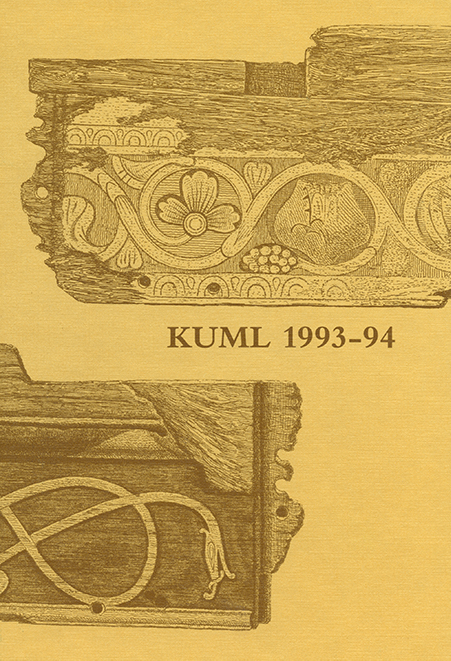Skeletal remains from St. Peder’s parish church in Randers
DOI:
https://doi.org/10.7146/kuml.v39i39.112330Keywords:
Skeletal remains, skt. Peders parish church, randersAbstract
Skeletal Remains from St. Peder's parish church in Randers
One of Denmarks 17 known Benedictine nunneries was excavated in Randers, Jutland in 1989 (Matthiesen 1989). Although it is not clear when the nunnery was established, it seems that the church, which was part of the nunnery, was built around 1100 A.D. The church, St. Peders, also served as parish church (fig. 1). Two graveyards were located: one south of the church presumably used by the nuns, and a second east of the church which was probably the parish cemetery (Mikkelsen 1990a, Mikkelsen 1990b).
The following is a brief account of the preliminary results of the anthropological analyses of the skeletal remains from the parish cemetery excavations. A minimum of 530 individuals were excavated, originating from 252 well defined single graves, several probable mass graves and stray finds (Mikkelsen & Matthiesen 1990). The most frequent type of burial was interment without coffin. Coffin burials were rare, and only six stone lined graves were found. It is assumed that the individuals found in the coffins and stone-lined graves represent people of a higher social status.
The skeletons
The preservation and completeness of the individual skeletons varied. Most of the large long bones were present. Roughly, one third of the material was well preserved, one third preserved to an average degree, and one third poorly preserved. It is noteworthy that 95 individuals were retrieved with all teeth present (apart from teeth lost ante mortem), and this testifies to the care with which the material was recovered.
Age and sex distributions
So far only the skeletal material from the single graves has been processed, yielding the following age distribution: 2 fetuses; 60 infants (0 to 12/14 years); 22 adolescents (12/14 to 21 years); and 215 adults (above 21 years) (fig. 2). Only few individuals were found to have an age exceeding 40 years. Subadults make up one third of the total material. Probably the real proportion was higher, up to 50%, due to the high child mortality of the period. However, the delicate bones of infants are not preserved to the same degree as the larger and denser bones of adults. The determination of sex is only possible for the adults, and revealed a fairly balanced distribution.
Paleopathology
Ordinary and well known pathological conditions affecting bones were found, e.g., many healed or partly healed fractures; inflammations and arthritis. One case of possible tuberculosis was found (see below). Generally, the types and rates of paleopathological changes agree with the results from other Medieval excavations (Møller-Christensen 1958). Although the early Benedictine nunneries to some extent functioned as hospitals (Trabjerg 1993), nothing definite can be deduced from the skeletons in this respect. Dental analyses revealed a low frequency of caries (88 individuals had caries), which is in agreement with results from other contemporary skeletal material (Mellquist & Sandberg 1939; Brinch & MøllerChristensen 1949). There was a clear correlation between caries and periapical abcesses, with half of the individuals with caries having abcesses (fig. 3). The degree of dental wear was moderate (fig. 4).
Anthropometry
The stature was calculated to be approx. 174 cm. (5' 9») for males and 157 cm. (5' 2») for females, well in accordance with other contemporary finds (Bennike 1985). Several other measurements, especially cranial measurements were taken, and these have since formed part of a large study of cranial morphology of Danish skeletons from the Stone Age to present days (Hjalgrim 1992).
Special graves
Although the purpose of the anthropological analyses was to reconstruct the population of the period, a few single cases attracted special attention:
Grave 13: The skeleton of a young, approx. 18 years old female was found (fig. 5) including the bones of two fetuses (twins, see figure 5) in the pelvic region. From the examination of the fetal bones it appeared that the woman died about 6 months into her pregnancy (fig. 6). The cause of death could not be established.
Stray find 510: A male cranium with the facial skeleton completely destroyed. A large iron ball, approx. 30 mm in diameter was found within the calvarium. Analyses at the Institute of Metallurgy at the Danish Engineering College indicated that the ball was made from 99% forged iron (Buchwald 1992, pers. comm.). Historical sources first mention firearms in Denmark in 1360 (Orloff, pers. comm.). The caliber, and the fact that the ball did not exit the skull, i.e. had a low muzzle velocity, indicates that the ball probably was fired from a small cannon (a so-called "skanseboesse"). This is the earliest firearms victim found in Denmark.
Grave 202: The skeleton of an approx. 25 years old female yielded an unusal curved vertebral column (fig. 7) and bones with significantly thinner cortical bone mass. Our tentative conclusion is that the woman suffered from tuberculosis. Tuberculosis has been reported both in historical sources and from other Medieval excavations (Møller-Christensen 1958).
Conclusion
The preliminary results from the excavation of the St. Peder parish cemetery in Randers, show a Medieval (skeletal) population not differing much from other contemporary finds. The results have already formed part of other studies (Hjalgrim 1992). We expect to commence a research programme into Medieval paleothology in cooperation with the Smithsonian Institution of Washington, D.C., U.S.A., and the University of Bradford, England. The Randers skeletal material will then be a valuable contribution.
B. Frøhlich, H. Hjalgrim, J. Littleton, N. Lynnerup og B. Sejrsen.
Published
How to Cite
Issue
Section
License
Fra og med årgang 2022 er artikler udgivet i Kuml med en licens fra Creative Commons (CC BY-NC-SA 4.0).
Alle tidligere årgange af tidsskriftet er ikke udgivet med en licens fra Creative Commons.


